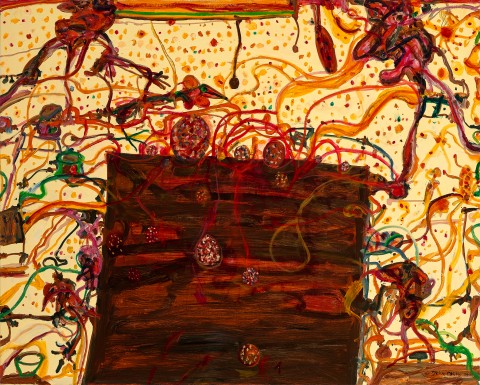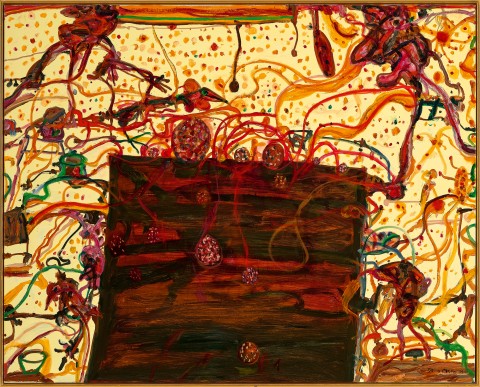TUSCAN KITCHEN, 2004
JOHN OLSEN
oil on linen
122.0 x 152.0 cm
signed and dated lower right: John Olsen 04
signed, dated and inscribed with title on frame verso: John Olsen 04 "Tuscan Kitchen"
Tim Olsen Gallery, Sydney (label attached verso)
Private collection, Sydney, acquired from the above in 2004
John Olsen, Recent Works 2004, Tim Olsen Gallery, Sydney, 19 October – 6 November 2004, cat. 6
McGregor, K., and Zimmer, J., John Olsen: Journeys Into the You Beaut Country, Thames & Hudson, Melbourne, 2016, pp. 238 (illus.), 340
We are grateful to Kylie Norton, Editor, John Olsen Catalogue Raisonné, for her assistance with this catalogue entry.
In many ways Olsen’s life and his art are inseparable. His oeuvre represents the cumulative response of an artist intoxicated with the landscape, its people and their attitudes towards food, life and art. Olsen’s dedication to the good life was legendary and this, along with his love of poetry, inspired much of the artist’s work. In fact, over many years the artist has been known to create entire exhibitions on the theme of food and cooking.
In her monograph on the artist in 1991, Deborah Hart revealed that it was necessity that introduced Olsen to the world of fine food: ‘In Ibiza and Deya, Olsen worked for brief periods as an apprentice chef. Before he left Australia, he was hard pressed to boil an egg; by the time he returned he had developed a great admiration for Mediterranean attitudes to food and wine – the joy of preparing and sharing meals with feeling – which, even when enjoying the simplest ingredients, had the potential to add to the richness and celebration of life. This sensibility would remain with him always, and the subject of food, and paella in particular, would recur in his later paintings and drawings.’1
Olsen infuses his paintings with a life beyond the literal. They do not simply present a subject as a static image, but as a rollicking yarn which unravels across the painting’s surface in great detail. Olsen’s Tuscan Kitchen, 2004 is a cacophony of activity, with the artist’s characteristic repertoire of wristy marks.
The focal point of the work is the kitchen table where the meal will be prepared and then shared. In a nod to Paul Cézanne the table is tilted forward, almost facing the viewer. In the upper left and right corners we see two figures; the one on the right (which may well be a self-portrait) appears as a floating head with tendrils flowing down around the table surface as though conjuring the meal. The circular dishes appear as small palettes laden with daubs of paint, which could easily be read as rustic Tuscan pizzas. Olsen presents the artist as the consummate creator, celebrator and consumer of the good life. Smaller, birdlike life forms dart and flit around the work and appear ready to pilfer ingredients at any moment.
As with most Olsen paintings, the line is central to the artist’s language as it forms the arteries that pulse colour around the canvas and bring life to the painting. The entire scene is upturned, and conventional perspective is abandoned. In its place is a field of action comprised of broad areas of colour which support the myriad marks that dart or meander across the surface. Where necessary, lines mass into forms which become focal points for the eye to settle upon just long enough to grasp the narrative, before moving on to the next pocket of activity.
The parallels between cooking and painting are many – the kitchen and the studio, the table and the canvas, the ingredients and the paint. Even the line between kitchen utensils and the artist’s tools had blurred in recent decades, with Olsen’s adaption of a culinary methodology to studio life blending the two inseparably in his work. Perhaps it is this merged celebration of life which has ensured his paintings still feel so vibrant and nourished over decades of artistic practice.
1. Hart. D., John Olsen, Craftsman House, Sydney, 1991, p. 42
HENRY MULHOLLAND


